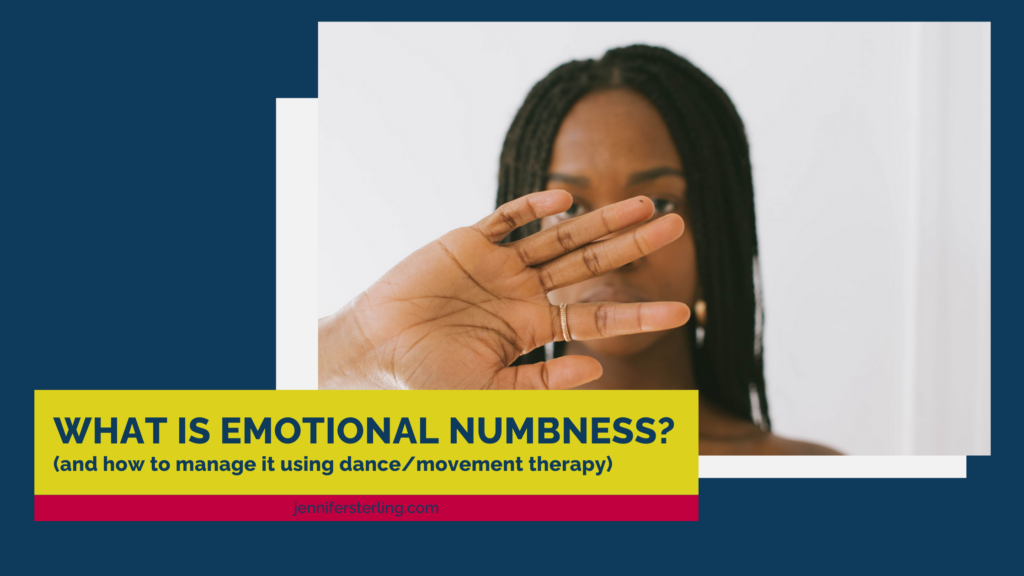If feeling your feelings feels like too much… don't worry, I got you.
What Is Emotional Numbness?
Have you ever felt like you’re moving through life, but not really living it?
You show up. You take care of things. You smile when you’re supposed to.
But inside? Nothing.
Not sadness. Not anger. Not joy.
Just…blank.
That feeling has a name: emotional numbness.
Let’s talk about what emotional numbness really is, why it shows up, and one gentle movement you can use to begin reconnecting with yourself without falling apart.

Why Emotional Numbness Happens
Your nervous system has one job: keep you safe.
When it senses that emotions could overwhelm you—whether sadness, fear, or even joy—it steps in and slows everything down. This is what Dr. Stephen Porges described in Polyvagal Theory as the “dorsal vagal” state. In this state, your autonomic nervous system slows you down and creates a shutdown response—a biological way to survive emotional overwhelm.
Emotional numbness is especially common if you’ve lived with:
- High stress or trauma
- Expectations to “be strong” and hide feelings
- Racism, sexism, or bias that punishes emotional expression
- Situations where crying, anger, or sadness felt unsafe

What Emotional Numbness Might Look Like
Emotional numbness doesn’t always look dramatic. In fact, it often looks pretty normal from the outside.
Maybe you show up to work, meet deadlines, and take care of your family. You laugh at jokes. You keep going.
But inside, you might feel like you’re:
- Floating through your day without really being present
- Smiling because you “should,” not because you’re feeling happy or content
- Watching other people react to life while you feel stuck behind a glass wall
- Feeling tired no matter how much you rest
- Not knowing how you feel at all
You might even find ways to distract yourself by doing things like scrolling, binge-watching, or working late. Without realizing, you’re trying to stay away from emotions that feel too big to address.
How Numbness Lives in the Body
In Dance/Movement Therapy (DMT), which uses movement to support emotional healing, we understand that numbness isn’t just mental—it’s physical.
Your body carries the story of what you’ve lived through.
When you’re emotionally numb, you might notice the following physical manifestations:
- Your shoulders rounding forward, protecting your heart
- Your breath becoming shallow or tight
- A feeling of heaviness in your chest or limbs
- Your spine curling inward, making yourself smaller
In Dance/Movement Therapy we know these bodily changes aren’t random. They’re survival strategies your body uses to keep you safe.
Instead of forcing yourself to “feel better,” you can learn to notice and work with these patterns gently, so your body and emotions start to work together again.
A Gentle Micro-Practice to Begin Feeling Again
Small Rocking to Restore Rhythm
One of the safest, most natural ways to begin reconnecting with yourself is through rocking—a slow, rhythmic movement that supports safety and connection.
Here’s how you can try it:
- Find a chair or sit comfortably on the floor with your feet on the ground.
- Rest your hands lightly on your thighs or your belly.
- Slowly, begin to rock your body forward and back—even just an inch or two.
- Move at a pace that feels easy and natural. You’re not rushing.
- Breathe gently as you rock, noticing any sensations that come up.
You can do this for 30 seconds, or a few minutes if it feels right for your body.
Why this works:
- Rhythmic movement helps restore a sense of connection and safety in the body.
- Predictable rhythm (like rocking) can calm the nervous system, signaling that it’s safe to feel again.
As you are rocking, try to focus on the movement. You don’t have to “figure out” your emotions, and you don’t have to “force” yourself to feel.
Remember this: if you feel numb, you’re not broken. Your body is doing exactly what it was designed to do — keep you safe.
You can start to feel again when you have the safety and support to do so.
If you’re ready for a gentle way to start feeling again, download my free guide:
3 Ways Black Women Learn to Numb (and How to Start Feeling Again).